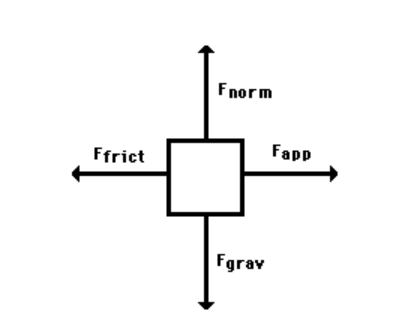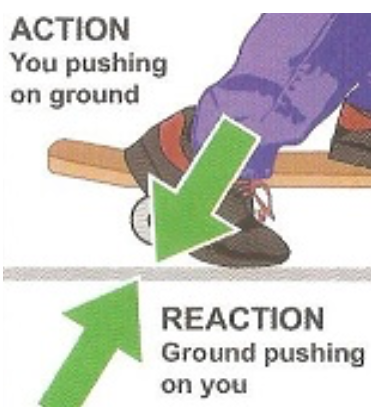2.5 Newton's Third Law and Free-Body Diagrams
6 min read•june 18, 2024
Peter Apps
Daniella Garcia-Loos
AP Physics 1 🎡
257 resourcesSee Units
Force Vectors ➡️
Forces are described by vectors.
Key Vocabulary: Vector - quantities that are described by a size (magnitude) and a direction (ex. East, Up, Right, etc.)
Example: The gas station is five miles west of the car
- Force, Displacement, Velocity, and Acceleration are vector quantities
Vectors can also be represented by arrows, and the length of the arrow should represent the magnitude of the described quantity. From the image below you can see the 5m arrow is smaller in length than the 50m arrow to reflect the difference in magnitude of the two quantities.

A force can be simply described as a push or pull. We know that a push or pull has both magnitude and direction (therefore, it is a vector quantity) and can vary considerably in both regards.
Key Vocabulary: Free-Body Diagram - as we discussed in previous standards, this is a technique used to illustrate all the external forces (forces that affect motion) acting on a body. The body is represented by a single dot or box, and only those forces acting on the body from the outside are pictured. Free-body diagrams are helpful in analyzing all forces acting on a system and are often utilized in the study and application of Newton’s laws of motion.

Image courtesy of physicsclassroom.com.
As pictured in the image above, Weight or Force of Gravity is always pointed downwards, Force of Normal is perpendicular to the surface, and Force of Friction is opposite motion. The applied force is in whatever direction the force is coming from (ie. the image could represent a hand pushing a box right across a level surface).
Here are some key points to remember about force vectors:
- A force vector is a quantity that has both magnitude and direction.
- The magnitude of a force vector is the strength of the force, while the direction of a force vector is the line along which the force acts.
- Force vectors are often represented by arrow diagrams, with the length of the arrow representing the magnitude of the force and the direction of the arrow representing the direction of the force.
- The sum of two or more force vectors is known as the resultant force. This can be calculated using vector addition.
- The force vector acting on an object can be used to calculate the acceleration of the object using Newton's second law of motion: F = ma, where F is the force vector, m is the mass of the object, and a is the acceleration of the object.
- Forces can be classified as either contact forces, which act when two objects are in contact with each other, or field forces, which act at a distance and do not require contact between the objects.
- Some common force vectors include gravity, tension, friction, and applied force.
⟶ Still feeling a little confused about Free-Body Diagrams? Don’t worry! Check out this video from Khan Academy for more practice!
Example Problem:
A box with a mass of 10 kilograms is being pushed across a floor by a person. The person is applying a force of 50 newtons to the right, and the floor is exerting a friction force of 30 newtons to the left.
- Draw a diagram showing the force vectors acting on the box.
- Calculate the resultant force acting on the box.
- Use Newton's second law of motion to calculate the acceleration of the box.
1. Draw a diagram showing the force vectors acting on the box:
[Diagram showing a box with a rightward force of 50 N and a leftward force of 30 N]
2. Calculate the resultant force acting on the box:
F = F1 + F2 = 50 N + (-30 N) = 20 N to the right
3. Use Newton's second law of motion to calculate the acceleration of the box:
F = ma = 20 N = (10 kg)(a)
a = 2 m/s^2 to the right
Force Interactions 🛠
A force exerted on an object is always due to the interaction of that object with another object.
Force is always the result of an interaction of two or more objects. No object has force on its own. Therefore, no object can exert a force on itself. When you clap your hands, one hand exerts a force on the other. When you throw a ball, it exerts a force on your hand and your hand exerts a force on it.

Image courtesy of sayingimages.com.
Force Pairs 🤝
If one object exerts a force on a second object, the second object always exerts a force of equal magnitude on the first object in the opposite direction.
Newton’s Third Law states, “For every action, there is an equal and opposite reaction.” Simply put, in every interaction, there is a pair of forces acting on the two interacting objects. The magnitude of the force on the first object equals the magnitude of the force on the second object. The direction of the force on the first object is opposite to the direction of the force on the second object. Forces always come in pairs - equal and opposite action-reaction force pairs.

Image courtesy of WikiHow.
Key Vocabulary: Action-Reaction Pair - the force exerted on an object is the action, and the force experienced by the object is the reaction. Action-Reaction pairs occur only when two objects interact. (Example: a foot pushing down on Earth <-> Earth pushing up on the foot.)
Here are some key points about force reaction pairs:
- When two bodies interact, they exert forces on each other. These forces are equal in magnitude and opposite in direction.
- For example, if a person pushes against a wall, the wall pushes back against the person with an equal and opposite force.
- The forces that act on the two bodies are known as action-reaction forces, or force pairs.
- According to Newton's third law of motion, whenever one body exerts a force on another body, the second body exerts an equal and opposite force on the first body.
- Force pairs always act in opposite directions, but they do not always cancel each other out.
- The net force on a body is the sum of all the forces acting on it. If the net force is zero, the body is in equilibrium and will not accelerate. If the net force is not zero, the body will accelerate in the direction of the net force.
There are many common force pairs that can act on two bodies when they interact with each other. Here are some examples:
- Gravity: When two bodies are attracted to each other due to their mass, they exert gravitational forces on each other. For example, the Earth and the Moon exert gravitational forces on each other, causing the Moon to orbit the Earth.
- Normal force: When a body is in contact with a surface, the surface exerts an upward force on the body to balance the downward force of gravity. This is known as the normal force.
- Tension: When a rope or string is pulled tight, it exerts a force on the objects it is connected to. This is known as tension.
- Friction: When two surfaces rub against each other, they exert a force that resists their relative motion. This is known as friction.
- Applied force: When a force is applied to a body, such as when a person pushes a box, the body exerts a force in the opposite direction. This is known as an applied force.
- Spring force: When a spring is stretched or compressed, it exerts a force that resists the deformation. This is known as the spring force.

🎥Watch: AP Physics 1 - Unit 2 Streams
Browse Study Guides By Unit
👟Unit 1 – Kinematics
🌀Unit 2 – Dynamics
🚀Unit 3 – Circular Motion & Gravitation
⚡️Unit 4 – Energy
⛳️Unit 5 – Momentum
🎸Unit 6 – Simple Harmonic Motion
🎡Unit 7 – Torque & Rotational Motion
💡Unit 8 – Electric Charges & Electric Force
🔋Unit 9 – DC Circuits
🔊Unit 10 – Mechanical Waves & Sound
📚Study Tools
🧐Exam Skills

Fiveable
Resources
© 2025 Fiveable Inc. All rights reserved.